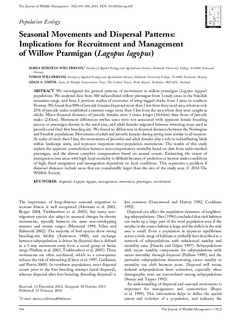Seasonal movements and dispersal patterns: Implications for recruitment and management of willow ptarmigan (Lagopus lagopus)
Journal article, Peer reviewed
Permanent lenke
http://hdl.handle.net/11250/191088Utgivelsesdato
2014Metadata
Vis full innførselSamlinger
Originalversjon
Hörnell-Willebrand, M., Willebrand, T. and Smith, A. A. (2014), Seasonal movements and dispersal patterns: Implications for recruitment and management of willow ptarmigan (Lagopus lagopus). The Journal of Wildlife Management, 78: 194–201. doi: 10.1002/jwmg.650 10.1002/jwmg.650Sammendrag
We investigated the general patterns of movements in willow ptarmigan (Lagopus lagopus) populations. We analyzed data from 300 radiocollared willow ptarmigan from 3 study areas in the Swedish mountain range, and from 2 previous studies of recoveries of wing-tagged chicks from 3 areas in southern Norway. We found that 80% of juvenile females dispersed more than 5 km from their natal area, whereas only 25% of juvenile males established a summer range more than 5 km from the area where they were caught as chicks. Mean dispersal distances of juvenile females were 3 times longer (10.4 km) than those of juvenile males (2.4 km). Movement differences within sexes were not associated with apparent female breeding success or ptarmigan density in the natal area, and adult females migrated between wintering areas used as juveniles and their first breeding site. We found no differences in dispersal distances between the Norwegian and Swedish populations. Movements of adult and juvenile females during spring were similar in all respects. At scales of more than 5 km, the movements of juveniles and adult females play a role in redistributing birds within landscape units, and represent important inter-population movements. The results of this study explain the apparent contradiction between non-compensatory mortality based on data from radio-marked ptarmigan, and the almost complete compensation based on annual counts. Estimating the extent of immigration into areas with high local mortality is difficult because of predation or harvest under conditions of high, fixed emigration and immigration dependent on local conditions. This represents a problem if dispersal distances include areas that are considerably larger than the size of the study area
